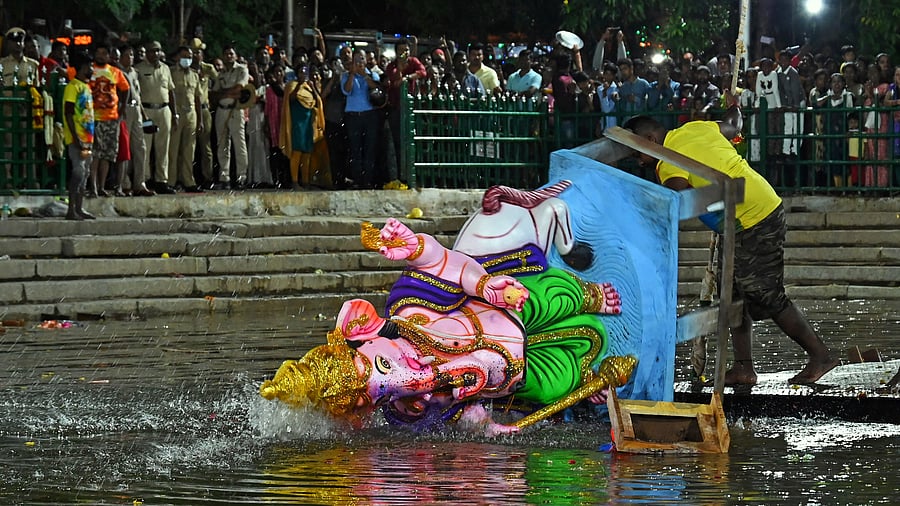
Most of the lakes witnessed a doubling or tripling of turbidity levels.
Credit: DH FILE PHOTO
The immersion of idols in the aftermath of Ganesha Chaturthi dealt a significant blow to the kalyanis of lakes, as indicated by worsening levels of acidity, turbidity, total dissolved solids (TDS), suspended solids, and chemical oxygen demand (COD) between September 18 and 30, according to data from the Karnataka State Pollution Control Board (KSPCB).
The KSPCB tested the quality of kalyanis in more than 30 lakes in Bengaluru on September 15 and compared it with daily tests conducted on five subsequent days: September 18, 20, 22, 24, 26, and 29. A total of 23 parameters were assessed, ranging from acidity (pH at 25 degrees C) to heavy metals like zinc, lead, and copper.
As expected, turbidity units worsened in most of the kalyanis, with many lakes showing an increase of five digits. For example, turbidity in Jakkur kalyani rose from 0.2 on September 15 to a five-day average of 44.2 units, an increase of 22000%. In Sankey Tank kalyani, the increase went up from 1.2 units to 32.5 units.
In Sankey Tank kalyani, the COD reached a peak of 200 mg/litre on September 24, with the five-day average standing at 115 mg/litre, an increase of 188% compared to the 40 mg/litre before the immersions began. The alkalinity of water increased from 68 mg/litre to 190.7 mg/litre.
The Central Pollution Control Board (CPCB) classifies water into five categories from Class A (drinking water) to E (industrial cooling), based on the safety limits of various parameters. However, the festival pushed several lakes beyond Class E.
Most of the kalyanis witnessed a doubling or tripling of TDS levels. In Ulsoor, the TDS went up from 278 mg/litre to 1546 mg/litre on September 29, with the five-day average settling at 781 mg/litre, an increase of 181%. The hardness of the water increased from 96 mg/litre to an average of 448.7 mg/litre.
Total suspended solids also increased in all the lakes. In Mallathahalli kalyani, the suspended solids went up from 2 mg/litre to 42 mg/litre on September 29. In Yelahanka, it increased from mg/litre to 44 mg/litre on September 24.
Among the heavy metals, zinc showed an uptick in two lakes in Peenya. Karihobanahalli Lake kalyani and Shivapura Lake kalyani had 0.256 mg/litre and 0.322 mg/litre zinc before the festival. It crossed 1.5 mg/litre in both lakes, with the five-day average settling at 0.400 mg/litre.
A senior KSPCB official said the government’s strict stance against plaster of paris idols has brought down the pollution compared to previous years.
“Once the ban is total, the lakes will fare much better. At the same time, the colour used to paint the idols needs to be checked. We need to ensure that only organic colours are used,” the scientist said.